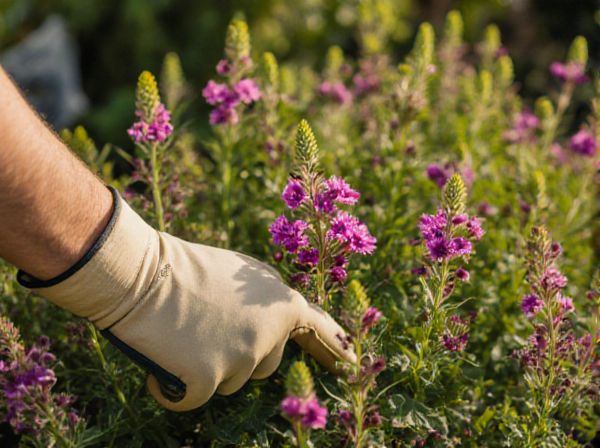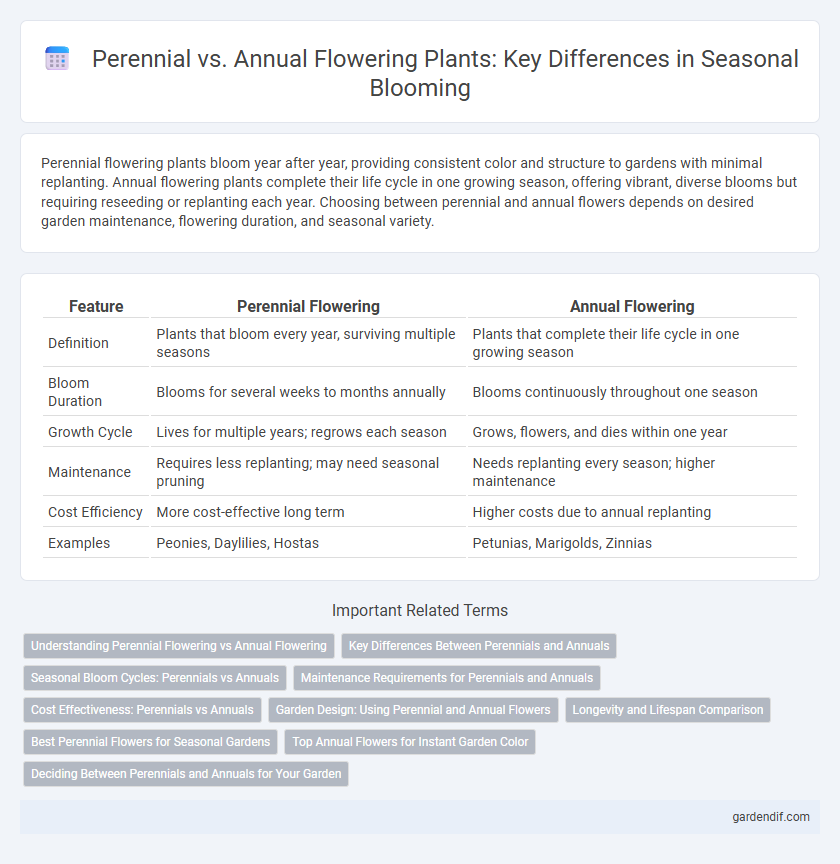
Perennial flowering vs Annual flowering Illustration
Perennial flowering plants bloom year after year, providing consistent color and structure to gardens with minimal replanting. Annual flowering plants complete their life cycle in one growing season, offering vibrant, diverse blooms but requiring reseeding or replanting each year. Choosing between perennial and annual flowers depends on desired garden maintenance, flowering duration, and seasonal variety.
Table of Comparison
| Feature | Perennial Flowering | Annual Flowering |
|---|---|---|
| Definition | Plants that bloom every year, surviving multiple seasons | Plants that complete their life cycle in one growing season |
| Bloom Duration | Blooms for several weeks to months annually | Blooms continuously throughout one season |
| Growth Cycle | Lives for multiple years; regrows each season | Grows, flowers, and dies within one year |
| Maintenance | Requires less replanting; may need seasonal pruning | Needs replanting every season; higher maintenance |
| Cost Efficiency | More cost-effective long term | Higher costs due to annual replanting |
| Examples | Peonies, Daylilies, Hostas | Petunias, Marigolds, Zinnias |
Understanding Perennial Flowering vs Annual Flowering
Perennial flowering plants bloom for multiple seasons, regrowing each year from the same root system, which makes them a sustainable choice for long-term garden planning. Annual flowering plants complete their life cycle within a single growing season, providing vibrant blooms but requiring replanting each year. Understanding the lifecycle differences between perennials and annuals helps gardeners select flowers based on maintenance preferences and seasonal aesthetics.
Key Differences Between Perennials and Annuals
Perennial flowering plants live for multiple seasons, blooming year after year, while annual flowering plants complete their life cycle within a single growing season. Perennials invest energy in root development for long-term survival, whereas annuals focus on rapid growth and seed production. This fundamental difference influences garden planning, maintenance, and bloom longevity, with perennials offering sustainable beauty and annuals providing vibrant, seasonal color.
Seasonal Bloom Cycles: Perennials vs Annuals
Perennial flowering plants exhibit seasonal bloom cycles that recur annually, allowing them to establish deep root systems and bloom consistently across multiple growing seasons. Annual flowering plants complete their entire life cycle, including germination, flowering, and seed production, within a single season, leading to intense but short-lived blooms. Understanding these seasonal bloom cycles helps gardeners plan continuous floral displays by combining perennials' lasting presence with annuals' vibrant, seasonal bursts.
Maintenance Requirements for Perennials and Annuals
Perennial flowering plants typically require less maintenance over time because they regrow each season from established root systems, reducing the need for replanting annually. Annual flowers, in contrast, demand more intensive care, including soil preparation, planting, and fertilization every growing season to ensure vibrant blooms. Selecting perennials can lower long-term gardening efforts and minimize resource use while annuals offer seasonal color diversity but with higher upkeep.
Cost Effectiveness: Perennials vs Annuals
Perennial flowering plants offer long-term cost effectiveness by returning each growing season without the need for replanting, reducing yearly expenses on seeds and plants. Annual flowers, while often cheaper upfront, require complete replacement every year, leading to higher cumulative costs over time. Choosing perennials supports budget-friendly gardening through sustained blooms and lower maintenance investment across multiple seasons.
Garden Design: Using Perennial and Annual Flowers
Perennial flowers provide long-term structure and seasonal rhythm in garden design, as they bloom year after year with minimal replanting, creating a stable foundation for garden composition. Annual flowers contribute vibrant color and dynamic changes each season, allowing gardeners to experiment with trends, fill gaps, and enhance focal points with diverse blooms. Combining perennials and annuals optimizes visual interest, extends flowering seasons, and balances maintenance efforts in landscape planning.
Longevity and Lifespan Comparison
Perennial flowering plants live for multiple growing seasons, often lasting several years or decades, offering prolonged blooming periods each season. Annual flowering plants complete their life cycle within a single growing season, producing flowers and seeds before dying off. The longevity of perennials provides ongoing garden structure and seasonal interest, while annuals offer vibrant, but short-lived, seasonal color.
Best Perennial Flowers for Seasonal Gardens
Perennial flowers like coneflowers, black-eyed Susans, and daylilies provide lasting beauty by blooming year after year, making them ideal for seasonal gardens. These hardy plants tolerate seasonal changes and require less replanting compared to annuals, which complete their life cycle in a single growing season. Selecting drought-resistant perennials enhances garden sustainability and ensures vibrant color through spring, summer, and fall.
Top Annual Flowers for Instant Garden Color
Annual flowers such as marigolds, petunias, and zinnias provide vibrant, instant garden color throughout the growing season, making them ideal for quick landscape transformation. Unlike perennials that take multiple seasons to establish and bloom consistently, annuals complete their life cycle in a single season, offering robust, continuous blooms from spring to fall. Gardeners often choose annuals to create striking beds, borders, and containers that deliver immediate visual impact.
Deciding Between Perennials and Annuals for Your Garden
Perennial flowering plants return year after year, providing lasting blooms and reducing replanting efforts, while annual flowering plants complete their life cycle in one season, offering vibrant, varied color throughout the garden. Choosing between perennials and annuals depends on factors such as garden design goals, maintenance preferences, and climate conditions that influence bloom time and plant longevity. Incorporating both types can create a dynamic and seasonally rich garden environment with continuous flowering interest.
Perennial flowering vs Annual flowering Infographic

 gardendif.com
gardendif.com